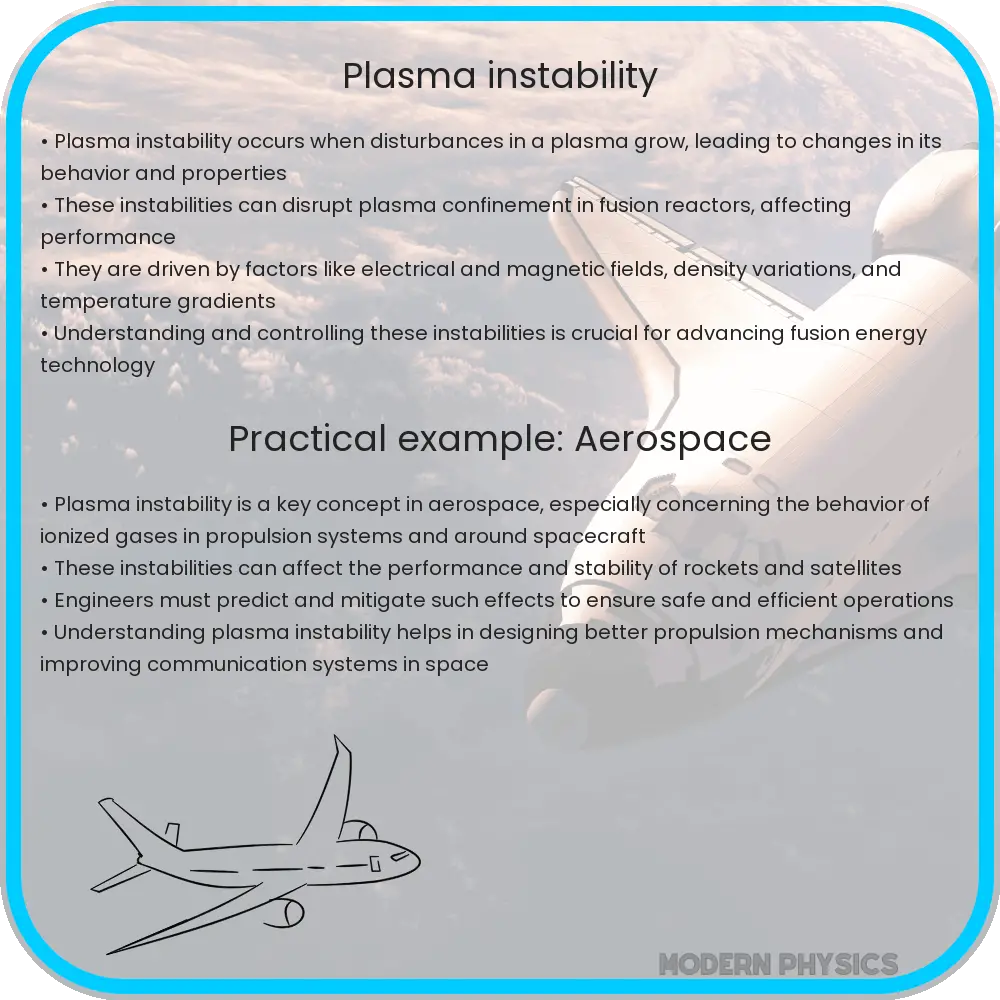Explore the causes, effects, and control methods of plasma instability in physics, crucial for advancements in nuclear fusion, astrophysics, and technology.

Understanding Plasma Instability: Causes, Effects, and Control
Plasma instability refers to the tendency of plasma (the fourth state of matter consisting of ionized gas with free electrons and ions) to undergo various forms of disturbances that can lead to uncontrolled and often undesirable behavior. These instabilities are critical in many areas of physics, particularly in controlled nuclear fusion research, astrophysics, and plasma technology applications. Understanding the causes, effects, and methods for controlling these instabilities is essential for harnessing the benefits of plasma in scientific and industrial applications.
Causes of Plasma Instability
Plasma instabilities are primarily caused by the complex interactions between electric and magnetic fields within a plasma. These interactions can lead to various types of instabilities, such as:
- Electrostatic instabilities, which are driven by the electric forces within the plasma.
- Magnetohydrodynamic (MHD) instabilities, which arise from the interplay between plasma’s magnetic fields and its fluid-like properties.
- Microinstabilities, caused by the distribution of particle velocities within the plasma, leading to phenomena like turbulence.
External factors, such as the presence of magnetic field gradients or temperature gradients within the plasma, can also contribute to the onset of instabilities. These gradients can induce currents and flows within the plasma, further complicating its behavior.
Effects of Plasma Instability
The effects of plasma instabilities can be both beneficial and detrimental, depending on the context. In controlled nuclear fusion, for example, instabilities can lead to the loss of plasma confinement, reducing the efficiency of energy production. In astrophysics, plasma instabilities play a crucial role in phenomena such as solar flares and the dynamics of the interstellar medium.
Detrimental effects include:
- Loss of plasma confinement, critical in fusion reactors.
- Energy dissipation, leading to reduced efficiency in plasma-based processes.
- Damage to containment structures due to uncontrolled plasma behavior.
However, understanding and harnessing certain instabilities can also lead to advancements in plasma control and manipulation, opening up new possibilities for technological innovation.
Control of Plasma Instability
Controlling plasma instability is a critical challenge in the field of plasma physics, especially for the advancement of nuclear fusion technology. Several strategies have been developed to manage and mitigate these instabilities, aiming to maintain plasma stability for longer periods and at higher efficiencies. Key approaches include:
- Magnetic Confinement: Using strong magnetic fields to confine plasma in a defined space, minimizing the contact with material surfaces and reducing the chances of instabilities.
- External Heating: Applying external heating methods like radiofrequency heating or neutral beam injection to control the plasma temperature and density profiles, thus stabilizing the plasma.
- Active Feedback Systems: Implementing real-time control systems that can detect the onset of instabilities and automatically adjust magnetic fields or plasma parameters to counteract these disturbances.
Advanced diagnostics and simulation tools also play a crucial role in understanding and predicting plasma behavior, allowing researchers to design more effective control strategies.
Conclusion
Plasma instabilities present both challenges and opportunities in the field of plasma physics. Understanding the underlying causes of these instabilities enables scientists and engineers to devise innovative solutions for their control. This is particularly crucial in endeavors such as controlled nuclear fusion, where plasma stability is paramount for achieving sustainable energy production. The effects of plasma instabilities are diverse, impacting a wide range of applications from industrial processes to astrophysical phenomena. With ongoing research and technological advancements, the methods for controlling plasma instability continue to evolve, paving the way for new applications and improvements in existing technologies. As we deepen our understanding of plasma behavior, the potential to harness its full capabilities becomes increasingly within reach, offering promising prospects for the future of energy, space exploration, and beyond.
